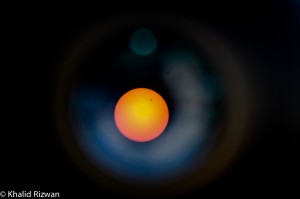2012 Transit of Venus
I took the day off yesterday to witness a rare astronomical event. It was me, four other adults and 16 boy scouts from St. Linus parish in Oak Lawn (southwest suburb of Chicago). We took a field trip down to Chicago’s Adler Planetarium to watch this century’s last Transit of Venus. I work with the boys as the Astronomy Merit Badge counselor. This event gave us a great opportunity to fulfill some of the requirements of the merit Badge and see an event that won’t be repeated in our lifetimes. The next Transit of Venus occurs in 2117! It seems that every time I set up a viewing session for the boys, we have had cloudy skies. But not yesterday! We were blessed with absolutely beautiful clear skies! Add this to the top-notch Adler facility and Chicago’s unforgettable skyline as a backdrop and it was a perfect day.
We arrived early which was good because we were able to visit the museum first and buy some Eclipse Shades to safely view the Sun. You cannot look directly at the Sun, especially through telescopes, binoculars and cameras. You need to use proper solar filtering. Later in the afternoon, the lines to buy these shades became quite long and they ran out, some some folks were disappointed. You could actually see the planet Venus as a tiny spot on the sun through the Eclipse Shades, but the best way to see it is through a properly filtered telescope or binoculars. There were many telescopes setup on the lawn of the Adler for the event.
I decided to bring my binoculars. I have Celestron 20/80 Astronomy binoculars. I fitted my binoculars with a homemade Solar Filter. I bought the Solar Mylar on eBay. It is manufactured by Thousand Oaks Optical. It worked out great. Maybe “too” great because after the boys and I took a look, a long line of patrons to the Adler began to form. There were thousands of people there and maybe a few dozen telescopes, so lines were long at all of them. So, for the next couple hours I was able to host amazing views of the transit from my humble setup. It was really neat seeing all the excited faces, both young and old! Lot’s of “oh wow” and “oh I see it!” and “what are those other spots?” (they are Sun Spots). Very cool indeed.
In the line I met a man named Khalid Rizwan. Khalid had a nice camera on him with a selection of lenses. He made several attempts to photograph the transit through my binoculars and I asked him to email the photo. Here is his result and what he had to say about it:
“Thanks for letting me have a couple of minutes to try to catch this shot from your setup. I couldn’t entirely clean it up, but I think the bit of reflection off the eyepiece just adds to the effect. I think it came out pretty well.”
I completely agree with his sentiment. I think the lens adds a nice moody effect. Venus is the black dot up near 1:00 O’clock. The other two smaller fuzzy black spots down below are Sun Spots. If you want to see more images, just Google Venus Transit and you’re bound to turn up hundreds. BTW, binoculars show the view “right-side-up”, a telescope would show the view “upside-down” or inverted. So if you turn up other pictures that show it the other way, that should explain it.
Clear skies everyone!
4 Responses to 2012 Transit of Venus
Comments are closed.
Categories
- Off Topic (1)
- Project Soane (2)
- BIM After Dark (Revit Kid) (2)
- Tips and Tricks (29)
- Oddities (5)
- Book News (23)
- Video Training News (7)
- Speaking Engagements (5)
- Renaissance Revit (12)
- Off Topic (8)
- Revit Concepts (1)

Very cool sir. Nice to see you passing this on to the next generation.
It was great fun. Thanks.
Cool Paul, thanks for sharing this!!!!
Nice hearing from you Diane. Thanks.